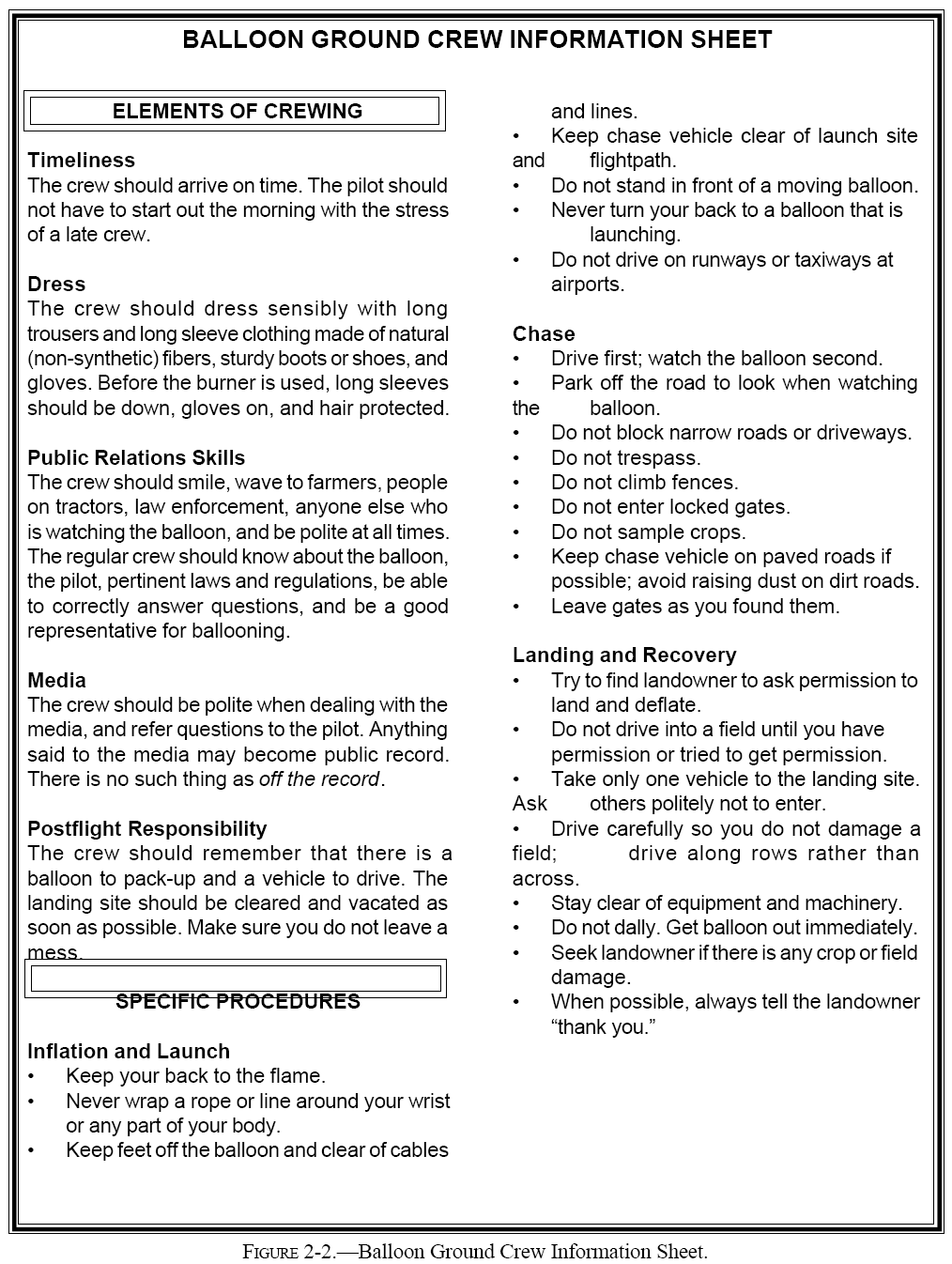Number of Crewmembers
The crew consists of people who help with the
inflation, chase, and recovery. Some pilots appoint
a crew chief, normally the most experienced
crewmember, but this is a matter of preference. A
crew chief is responsible for other crewmembers,
organizing the chase, and supervising the recovery.
Remember though, the responsibility for all aspects
of the flight, including ground operations, rests with
you, the pilot.
The number of crewmembers is a matter of individual
preference and depends upon the size of the balloon,
purpose of the flight, terrain, and other factors. When
using a small balloon for instruction, a crew of three
people, including the instructor, student, and one crew,
is sufficient. For passenger flights in large balloons, a
larger number of crewmembers is generally required.
Some experienced chase crews prefer to chase alone,
some prefer someone along to read a map. Having too
many people in the chase vehicle can be a distraction
for the driver, who is concentrating on staying near the
balloon.
Clothing
Crewmembers should be clothed for safety and
comfort. Cover or restrain long hair. Wear only long
sleeves and long trousers made of cotton and not
synthetic material. Try to wear clothes in layers since
temperatures can change quite a bit from before
sunrise to during the recovery. Proper clothing
protects participants from burns, poison oak/ivy, and
other harmful plants.
All crewmembers should wear gloves, preferably
smooth leather, loose fitting, and easy to remove.
Wear comfortable and protective footwear. If it
becomes necessary to walk or hike from a landing
site inaccessible by the chase vehicle, proper
clothing and footwear makes the task easier and less
hazardous.
Crew Briefings
Crew briefings vary from a few last minute
instructions (to an experienced, regular crew), or a
long, detailed discourse on how to layout, assemble,
inflate, chase, recover, and pack a balloon. You can
give crew briefings by telephone the night before, or in the chase vehicle on the way to the launch site,
but most crew briefings are done at the launch site
prior to the flight. It is important for the pilot to
remember who is ultimately responsible for the entire
operation and that the crew is the pilot’s
representative on the ground.
Written instructions are a good way to help the crew
while the pilot is aloft. Keep a loose-leaf, three-ring
binder in the chase vehicle containing crew instructions
and maps. This is a useful aid to an inexperienced
crewmember. A sample balloon ground crew
information sheet is provided. [Figure 2-2]

Types of Flight
The type of flight is important to the crew, so they
know the goals of the operation; the possible time
aloft; the probable direction(s) of flight; probable
altitudes; communications, if any, to be used; and
useful maps or charts.
Balloon flights can be classified into several different
types: paid passenger, instruction, race, rally,
advertising/promotion, and fun.
Many balloon pilots defray the cost of the sport by
offering paid passenger rides. The crew should know
that these passengers are paying for the privilege,
and may have been promised a certain type and length
of flight.
Instructional flights require that the crew follow the direction
of the instructor, so the student may see and participate as
much as possible. The crew should work closely with the
instructor and student and not take over any portion of the
operation, thus denying the student the opportunity to learn.
For races, crew responsibilities may be different. The pilot
may have only a single goal in mind and will zero-in on
that goal. The crew’s job is always to help the pilot, but in
the case of the race flight, the crew should try to relieve the
pilot of some of the routine tasks so he or she may concentrate
on the competition.
Many rallies, require pilots to carry passengers.
Sometimes passengers can be part of the inflation
crew. In any case you and your crew should treat
them graciously as they are, one way or another, paying for the benefits of the event. In unknown territory,
you should provide the chase crew with maps, and, if
desired, a local person to act as guide.
A typical flight briefing may be “I intend to make a 1-
hour flight and I have about 2 hours of fuel on board.
From my weather briefing and the pibal, I should travel
in a southeasterly direction, but if I go west I will land
before getting to the freeway. I will probably do a lot of
contour flying, but may go up to 2,000 feet to look
around. Let’s use channel one on the radio. There is a
county road map on the front seat.”
As stated before, the optimum size inflation crew for a
sport balloon is four people—the pilot operating the
burner, two people holding the mouth open, and one
person on the crown line. Many pilots prefer a larger
number of crewmembers; however, it is important to
be aware that too many crewmembers may often be
working against each other due to lack of
coordination.
|

